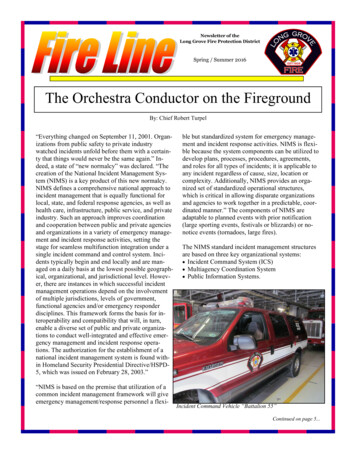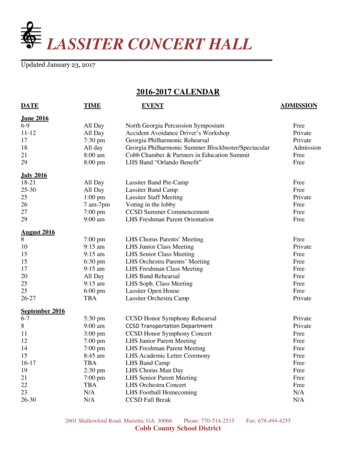
Transcription
Newsletter of theLong Grove Fire Protection DistrictSpring / Summer 2016The Orchestra Conductor on the FiregroundBy: Chief Robert Turpel“Everything changed on September 11, 2001. Organizations from public safety to private industrywatched incidents unfold before them with a certainty that things would never be the same again.” Indeed, a state of “new normalcy” was declared. “Thecreation of the National Incident Management System (NIMS) is a key product of this new normalcy.NIMS defines a comprehensive national approach toincident management that is equally functional forlocal, state, and federal response agencies, as well ashealth care, infrastructure, public service, and privateindustry. Such an approach improves coordinationand cooperation between public and private agenciesand organizations in a variety of emergency management and incident response activities, setting thestage for seamless multifunction integration under asingle incident command and control system. Incidents typically begin and end locally and are managed on a daily basis at the lowest possible geographical, organizational, and jurisdictional level. However, there are instances in which successful incidentmanagement operations depend on the involvementof multiple jurisdictions, levels of government,functional agencies and/or emergency responderdisciplines. This framework forms the basis for interoperability and compatibility that will, in turn,enable a diverse set of public and private organizations to conduct well-integrated and effective emergency management and incident response operations. The authorization for the establishment of anational incident management system is found within Homeland Security Presidential Directive/HSPD5, which was issued on February 28, 2003.”“NIMS is based on the premise that utilization of acommon incident management framework will giveemergency management/response personnel a flexi-ble but standardized system for emergency management and incident response activities. NIMS is flexible because the system components can be utilized todevelop plans, processes, procedures, agreements,and roles for all types of incidents; it is applicable toany incident regardless of cause, size, location orcomplexity. Additionally, NIMS provides an organized set of standardized operational structures,which is critical in allowing disparate organizationsand agencies to work together in a predictable, coordinated manner.” The components of NIMS areadaptable to planned events with prior notification(large sporting events, festivals or blizzards) or nonotice events (tornadoes, large fires).The NIMS standard incident management structuresare based on three key organizational systems: Incident Command System (ICS) Multiagency Coordination System Public Information Systems.Incident Command Vehicle “Battalion 55”Continued on page 5.
Interesting CallsBy: Deputy Chief Marc SmallIn October, crews were dispatched for a motorvehicle accident at Old Route 53 and RobertCoffin Road. A Deputy Chief, Rescue pumper,and Ambulance responded. Command was established after conducting a scene size-up andthe incident was upgraded to an entrapment response. Four vehicles were involved; one having heavy damage trapping the driver. The FireChief and our second ambulance respondedalong with assistance from Lake Zurich FRD,Palatine FD, Buffalo Grove FD and Lincolnshire-Riverwoods FPD. A total of four ambulances were used to transport five patients toarea hospitals with non-life threatening injuries.Three other individuals involved were evaluatedbut refused transport and signed medical releases.In November, we were dispatched to NicholsRoad for smoke in the building at a multi-familyapartment building in unincorporated ArlingtonHeights. Responding were the Fire Chief, Rescue Pumper, Pumper Tender, and an ambulance.Automatic Aid companies from Palatine FD,Buffalo Grove FD, Palatine Rural FPD, LakeZurich FRD, Arlington Heights FD and Prospect Heights FPD also responded. First to arrive was the Palatine engine. They reportednothing showing from the front of the building;at that time the Long Grove Shift Commanderarrived and established command. Palatinemade entry to the unoccupied first floor apartment through a sliding glass door. They reportedmild smoke and found a pan of food smolderingon the stove. The stove was turned off and thepan of food was safely removed from the apartment, then extinguished outside. Crews spentseveral minutes removing the smoke from theapartment and no injuries reported.On the following day, crews were dispatched toanother Nichols Road address for a possible firein a multi-family apartment building in unincorporated Arlington Heights. The Shift CommandPage 2er, Fire Chief, Deputy Fire Chief, RescuePumper, Pumper Tender, and an ambulance allresponded. Also responding were Automatic Aidcompanies from Palatine FD, Buffalo Grove FD,Palatine Rural FPD, Lake Zurich FRD and Arlington Heights FD. Upon arrival, the Palatineengine reported nothing showing from the frontof the building when the Long Grove Shift Commander arrived and established command. Palatine reported smoke in a second floor apartmentand forced entry after not receiving an answerfrom inside. Moderate smoke was found in theapartment. A fire was located in the kitchenabove the stove. The incident commander requested a call-back for off-duty Long Grove Firefighters and change of quarter’s companies fromProspect Heights FPD and Barrington Countryside FPD to cover our station. The fire wasquickly extinguished with a water can fire extinguisher. It was contained to the ventilation hoodand cabinets above the stove. The kitchen sustained moderate smoke damage and the windowwas removed to help evacuate the smoke. Firecrews evacuated all six units in the 3-story apartment building while confirming the fire did notspread to any other units. No one was home atthe time of the fire and no injuries were reported.Fire investigators determined it to be accidental,caused by unattended cooking.In February, crews were dispatched for a motorvehicle accident with entrapment on Lake CookRoad at Old Route 53. Responding were the Battalion Chief, Fire Chief, Deputy Chief, RescuePumper, and Ambulance, along with AutomaticAid companies from Palatine FD, Buffalo GroveFD and Lincolnshire-Riverwoods FPD. Uponarrival, the Battalion Chief reported two vehiclesinvolved with heavy front-end damage to a midsize auto and moderate damage to a full-sizeSUV. An off-duty Long Grove Firefighter/Paramedic was on the scene attempting to makeentry to the driver and only occupant of the automobile. It appeared that the driver was entrappedContinued on page 4.
Anatomy of a building:What takes place during the building process?By: Fire Marshal Michael SchmittWhen someone decides to construct a new building, there are many steps that occur during theperiod that the building is being constructed. Thefirst step is applying for a village building permitwhich requires an application to be filled out and afee to be paid. The building department then notifies the LGFPD Fire Prevention Bureau of theupcoming permitFor the next step, an overall set of plans called"site plans" are submitted for review. These planscover foundation, domestic water mains and fireprotection water mains, basic overall footprint of the building (which will includefire access road specifications), landscaping plans and any other informationpertaining to the exterior building information.There are then many specialized planssubmitted which will cover a life safetyplan, fire protection plan which may include sprinkler plans and fire alarm system plans. There are also electrical planswhich include lighting plans, detailedceiling plans, plumbing plans, and forlarger office buildings there might befurniture plans. The building departmentreviews all construction related plans andthe Fire Prevention Bureau reviews thelife safety, sprinkler and fire alarm plans.Once all reviews are completed and approved. then construction of the building canbegin.During the construction phase, the Fire PreventionBureau will stop by the construction site occasionally to observe the progress of the building, to spotcheck and make sure the plans are being followedcorrectly. During this time the building department and the Fire Prevention Bureau also havevarious inspections to perform. The Fire Prevention Bureau will perform a rough inspection and ahydro inspection on the sprinkler system and wewill also make sure the insulation has been installed properly to prevent the sprinkler pipingfrom freezing in the cold weather. The Fire Prevention Bureau will also check on the installationof the fire alarm system.Once the building construction is completed and isready to be occupied there are a few items left todo. The building department needs to do severalfinal inspections for plumbing, electrical and afinal sign off for the construction permit. The FireExample of Site PlansPrevention Bureau also has several final inspections to be completed for the sprinkler systemwhich will be tested to make sure it’s fully operational. There will also be a final inspection for thefire alarm system where each device of the firealarm system will be tested to make sure the system will be fully operational before occupancy isgranted. The building department and the fire department will then sign off on the permit and thebuilding is turned over to the owner for occupancy.Page 3
.continued from page 2in the vehicle. When the pumper squad and ambulance arrived, crews split up and worked on accessing thedriver of the automobile and checked the SUV for injuries. Six occupants were found in the SUV; two passengers were having medical complaints. The Palatine ambulance arrived and the two occupants were transported to Northwest Community Hospital in Arlington Heights with non-life threatening injuries. Crewsmade access to the driver of the auto by breaking a rear window and unlocking the driver’s side door. Thedriver was removed and transported by the Long Grove ambulance to Lutheran General Hospital in ParkRidge, with life threatening injuries. The Fire Chief was assigned operations. The Buffalo Grove unit assisted in checking and controlling hazards from the damaged vehicles while the Pumper Squad crew reassessedthe remaining occupants of the SUV for injuries. Two of them then requested transport; a Lake Zurich FRDambulance was requested to transport them to Northwest Community Hospital with non-life threatening injuries. While the driver and the last remaining passenger refused further assistance and signed medical releases. The Deputy Chief and Lincolnshire-Riverwoods pumper squad were redirected from the scene to thefire station to cover our district during the incident.LGFPDMissionStatementTo provide residents, owners, businesses, and visitors within the LongGrove Fire Protection District, andany recognized emergency agencyrequesting automatic/mutual aid,with the safest, effective, efficient,comprehensive, and customer focused Fire, Rescue, and EmergencyMedical Services possible. This highlevel of professional services will notbe limited in scope to emergency situations only, but will encompass thebroader spectrum of public safety, toinclude Public Education, Fire Inspections, and all other support services.Page 4Calendarof EventsApril 5May 10June 14June 20July 12August 2September 6September 12October 4CPR/AED ClassCPR/AED ClassCPR/AED ClassFirst Aid ClassCPR/AED ClassCPR/AED ClassCPR/AED ClassFirst Aid ClassCPR/AED ClassClasses begin at 6 pm. Class fees are 15 forresidents of LGFPD, 30 for non-residents.Call Jeff Baygood for additional information at847-634-3143.
.continued from page 1“The most familiar component of NIMS to mostmembers of the public safety community is ICS, asystem for domestic incident management that isbased on an expandable, flexible structure and thatuses common terminology, positions and incidentfacilities. ICS is used to organize on-scene operationsfor a broad spectrum of emergencies from small tocomplex incidents, both natural and manmade. Toeffectively manage incidents, the ICS organizationdepends on five major functions: Command Operations Planning Logistics Finance/Administration.A sixth function, Intelligence/Investigations may beadded at the discretion of command.”Mostly, this article will delve into the command portion of ICS as it pertains to the Long Grove Fire Protection District (LGFPD or District). The ICS hasthree types of command: Single Incident Commander: incident occurs withinFront seat of Incident Command Vehiclea single jurisdiction and there is no jurisdictional orfunctional agency overlap (this does not mean thatother agencies do not respond or do not have a rolein supporting the management of the incident), thisis most common format utilized daily Unified Command: when there is more than oneresponding agency with responsibility for the incident or the incident crosses jurisdictional lines Area Command: is an organization established tooversee management of multiple incidents beingmanaged by an ICS organization or to overseemanagement of large incidents that cross jurisdictional boundaries.The ICS is utilized to facilitate the completion oftactical priorities. The Incident Commander (IC) isthe person who drives the system toward that end.The IC is responsible to establish a command structure that matches the organizational needs of theincident to achieve the completion of the tacticalpriorities for the incident. The Functions of Command (see below) defines standard activities that areperformed by the IC to achieve tactical priorities.The Responsibilities of Command/Tactical Prioritiesinclude: Remove endangered occupants and treat the injured Stabilize the incident and provide forlife safety Conserve property Provide for the safety, accountabilityand welfare of all personnel and thegeneral public throughout the durationof the incident.The Functions of Command include: Assume and announce Command andestablish an effective operating position(Command Post) Rapidly evaluate the situation (sizeup) Initiate, maintain and control the communication process. Assign tactical radio frequencies as needed Identify the overall strategy, developan incident action plan (IAP) and assigncompanies and personnel consistentwith plans and standard operating guidelines Ensure scene safety; establish a safety officer asnecessary. Assign assistant safety officer whenneeded Ensure personnel accountability; establish a personnel accountability officer as necessary. AssignContinued on page 6.Page 5
.continued from page 5accountability responsibilities to division/groupsupervisors as necessary Provide and communicate tactical objectives Review, evaluate and revise (as needed) the IAP Provide for the continuity, transfer and termination of Command Ensure adequate coverage for the remainder of thejurisdiction (Change-of-Quarters) Utilize the tactical work sheet Request and assign alarm levels and/or mutual aid Establish liaison with other local governmentagencies and officials, outside agencies, propertyowners and/or tenants Utilize Command checklist to ensure performanceof Command functions.At this point, it is important to note that we are anall hazards/full service fire department. The ICSutilized by the District is implemented on all type ofscenes warranting such action. It can be applied/adopted to structure fires, vehicle accidents, specialrescue events (dive rescue/recovery, entrapment/pinin accidents, hazardous materials incidents,wildland fires, confine space rescues, trench rescues,multi-patient/mass casualty incidents and high anglerescue situations).On a daily basis, the person who usually would perform the Incident Commander role is the on-dutyBattalion Chief. As you may recall from previousissues of this newsletter, LGFPD is heavily involvedwith other agencies providing/receiving automaticresponse/mutual aid. In total, we have 13 shared/reciprocating automatic response agreements withneighboring agencies and are members of a largershared resource group, the Lake County Mutual AidBox Alarm System (MABAS) Division 4. MABASDivision 4 in turn is a member of the statewide organization MABAS-Illinois. The concept ofMABAS crosses over our state line into several other states on a national level. The MABAS motto is“We Got Your Back.” All of this readily availableassistance must be appropriately managed early inan involved emergency situation. The person initially charged with such a critical task is our on-dutyBattalion Chief. If you were to take the previouslymentioned four Command responsibilities/tacticalpriorities and add in all the functions of commandPage 6and make a list of tactical considerations an incidentcommander must take into account (during a structure fire, for example) in order to properly run theincident and achieve the best results, this would be acomprehensive list of those considerations: Conduct initial 360 degree size-up and maintaincontinuous 360 degree size-up throughout the duration of the incident Rapidly interview witnesses for critical information; such as are persons in the structure, whereare they, where is the fire, layout of the structure Establish Command (Single Incident Commander,Unified Command, Area Command) Identify limited access problems Declare mode of operation (Investigation, Rescue,Offensive, Transitional, Defensive) Call for help, if needed Address difference in residential/commercial mentality Apparatus Placement/Hoseline Placement Occupant survival profile Sprinkler/Standpipes present Examine/review existing preplans Attack Fire-adequate gallons per minute (gpm),needed fire flow (length x width/3 per floor, whatsize hoselines to use Ensure back-up hoseline(s) are deployed and arethe correct size Ensure primary search for fire victims is completed Ensure medical group set-up to treat/transport victims, ensure enough staffing is present to assistambulance crews if needed Ensure secondary search for fire victims is completed Ensure coordinated ventilation with attack team isperformed, monitor flow paths Will aerial operations be needed Exposure problems due to nearby structures, vehicles, etc. Comply with OSHA Two-In/Two-Out, Rapid Intervention Team, are multiple teams needed due totype of operations/size of structure, what team sizeshould be deployed Water supply (city hydrant water available, drafting hydrants nearby, tanker nurse operations, largediameter hose relay, tanker shuttle operation, combination of above, joint hose tender needed, whereContinued on page 7.
.continued from page 6 Closely monitor the weather and react accordingly Is plan working: update/modify strategy & tactics;Back seat of Incident Command Vehicle includes a desktopfor an assistant (when needed)will the fill sites for tankers be located, how manytankers are necessary, what is the needed expectedfire flow Maintain accountability of emergency personneland civilians Ensure fire extension checks are completed, remember there are six sides to a fire (up, down,front, back, left, right) Ensure overhaul operations are completed Ensure salvage operations are completed Monitor for hostile fire events (flashover, backdraft, flow path problems, wind driven fires, etc.) Monitor structure integrity/building construction(collapse zones, if needed) Ensure proper communications are taking placebetween all the personnel, are you receiving timely pertinent information (assign tactical channels) Conduct personnel accountability reports as needed Ensure you are receiving appropriate progress reports Ensure you have a plan for emergency evacuation Ensure utilities are secured in a timely fashion, ifneeded (gas, electric, water) When appropriate, continuously monitor for airquality in structure (carbon monoxide, hydrogencyanide, oxygen) Gather on-going reconnaissance information/intelligenceperiodically re-evaluate, be flexible; beware of unexpected delays, unusual circumstances Expand ICS as necessary (safety officer, press information officer, liaison officer, section chiefs,division/group supervisors, branches) Ensure proper size rehab group implemented foramount of emergency personnel on scene and forany adverse weather conditions, two ambulances(at least one for transport, one for rehab), MESSCanteen (if needed), bottled water, set up air stationfor SCBA bottle refill, shelters, heating/coolingunits Ensure lighting equipment available if needed Stage incoming apparatus/vehicles/equipment appropriately (Level I or Level II staging), do notblock access to scene Request a callback of off-duty personnel/ensurethere are change-of-quarters companies coveringthe Long Grove station Update tactical worksheet Request District fire investigators, how many arenecessary, do we need outside help Ensure all other notifications (internal/external) aremade based on the type of incident Ensure proper traffic/site control & securitymeasures are in place Achieve customer stabilization.As you can see the responsibilities of an incidentcommander in a situation such as this is daunting. Itis imperative that someone is assigned to operate asthe incident commander early on in any significantevent. Failure to do so will most assuredly result innegative outcomes possibly catastrophic in nature.The task at hand is so overwhelming that the sooneran incident commander can expand the ICS withmore “bosses,” the sooner he can limit his span ofcontrol so he can effectively manage the incident andfocus on the “big picture” at hand. The incident commander truly is the orchestra conductor on the fireground.Sources:National Incident Management System: Principles And Practice,Second Edition, 2012.NIMS-Incident Command Standard Operating Guideline,LGFPD, 19 April 2012.Page 7
Fire LinePresorted Standard MailUS Postage PaidPermit No. 1111Palatine P&DCA newsletter ofLong Grove Fire Protection District1165 Old McHenry RoadLong Grove IL 60047847-634-3143Emergency always dial 9-1-1Non-emergency 847-634-3143Board of TrusteesDavid Klein, PresidentStephen Wernikoff, TreasurerDonald Biciste, SecretaryBoard of CommissionersGary Morris, ChairpersonMarsha Forsythe, CommissionerLawrence Kluge, CommissionerStaffRobert Turpel, ChiefBrian Beck, Deputy ChiefMarc Small, Deputy ChiefKaryn Rios, Administrative AssistantChristmas Wreath Sale UpdateThank you for participating in theChristmas Wreath sale over the pastyears. We only raised 670 (net) in2015. Unfortunately, costs for printingand postage were 1300. As everyoneknows, postage has gotten very expensive. For 2016 we are going to trysomething different. We will NOT bemailing out cards like we have for thelast 14 years. We will go digital, byusing E-mail, instead of mailing thecards. What I’m asking of you now, isto send me an E-mail asking to beplaced on our Wreath Sale notificationlist. Then, in October I will send youan E-mail asking if you would like topurchase a wreath. Everything elseremains same. You place your order and receive your wreath products in the second half of November. Asalways, prepaid orders receive FREE DELIVERY. Thanks again for your support.Battalion Chief John Jaworskijjaworski@lgfpd.org847-634-3143
April 5 CPR/AED Class May 10 CPR/AED Class June 14 CPR/AED Class June 20 First Aid Class July 12 CPR/AED Class August 2 CPR/AED Class September 6 CPR/AED Class September 12 First Aid Class October 4 CPR/AED Class Classes begin at 6 pm. Class fees are 15 for residents of LGFPD, 30 for non-residents.











